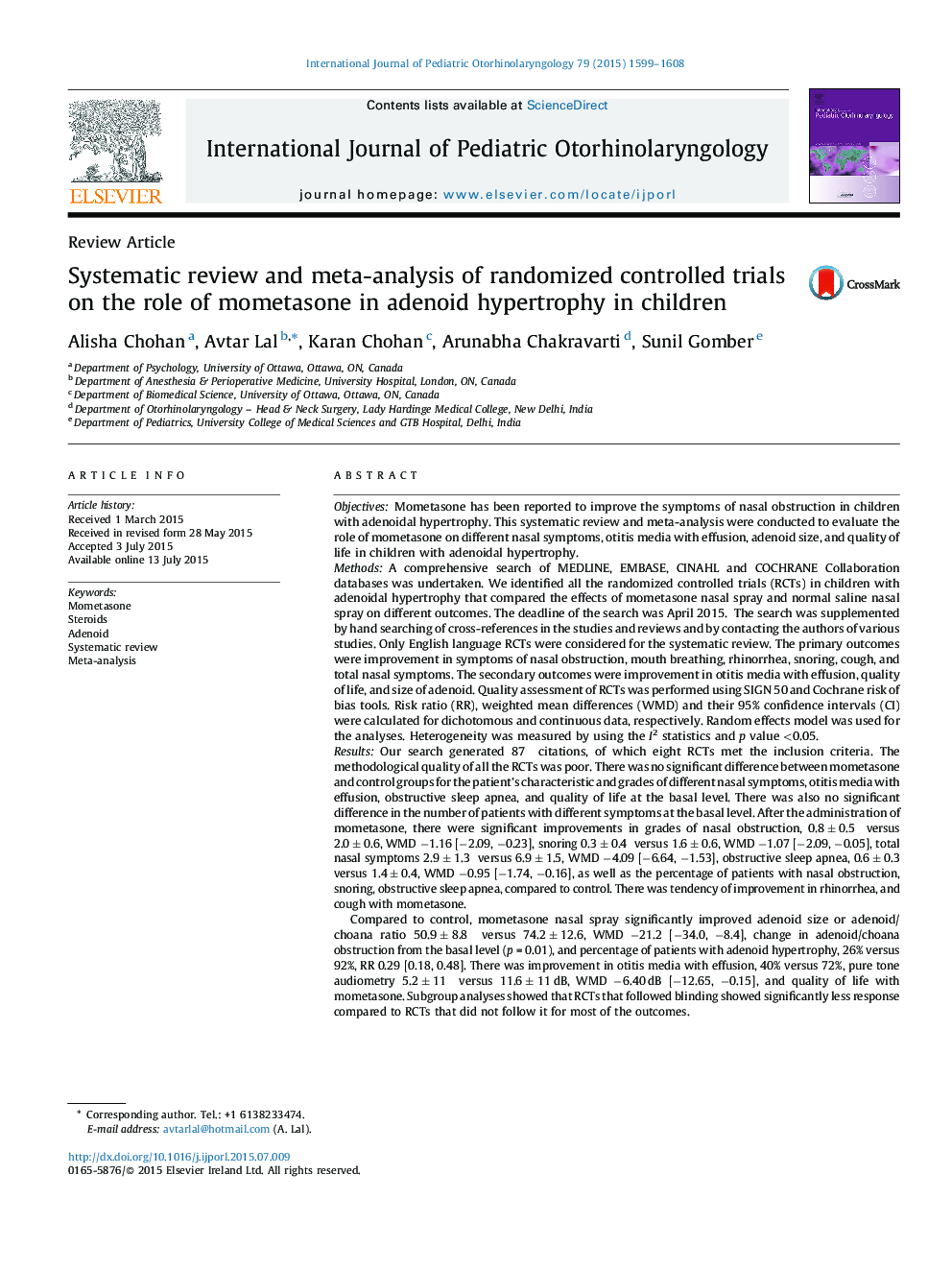| Article ID | Journal | Published Year | Pages | File Type |
|---|---|---|---|---|
| 4111914 | International Journal of Pediatric Otorhinolaryngology | 2015 | 10 Pages |
ObjectivesMometasone has been reported to improve the symptoms of nasal obstruction in children with adenoidal hypertrophy. This systematic review and meta-analysis were conducted to evaluate the role of mometasone on different nasal symptoms, otitis media with effusion, adenoid size, and quality of life in children with adenoidal hypertrophy.MethodsA comprehensive search of MEDLINE, EMBASE, CINAHL and COCHRANE Collaboration databases was undertaken. We identified all the randomized controlled trials (RCTs) in children with adenoidal hypertrophy that compared the effects of mometasone nasal spray and normal saline nasal spray on different outcomes. The deadline of the search was April 2015. The search was supplemented by hand searching of cross-references in the studies and reviews and by contacting the authors of various studies. Only English language RCTs were considered for the systematic review. The primary outcomes were improvement in symptoms of nasal obstruction, mouth breathing, rhinorrhea, snoring, cough, and total nasal symptoms. The secondary outcomes were improvement in otitis media with effusion, quality of life, and size of adenoid. Quality assessment of RCTs was performed using SIGN 50 and Cochrane risk of bias tools. Risk ratio (RR), weighted mean differences (WMD) and their 95% confidence intervals (CI) were calculated for dichotomous and continuous data, respectively. Random effects model was used for the analyses. Heterogeneity was measured by using the I2 statistics and p value <0.05.ResultsOur search generated 87 citations, of which eight RCTs met the inclusion criteria. The methodological quality of all the RCTs was poor. There was no significant difference between mometasone and control groups for the patient's characteristic and grades of different nasal symptoms, otitis media with effusion, obstructive sleep apnea, and quality of life at the basal level. There was also no significant difference in the number of patients with different symptoms at the basal level. After the administration of mometasone, there were significant improvements in grades of nasal obstruction, 0.8 ± 0.5 versus 2.0 ± 0.6, WMD −1.16 [−2.09, −0.23], snoring 0.3 ± 0.4 versus 1.6 ± 0.6, WMD −1.07 [−2.09, −0.05], total nasal symptoms 2.9 ± 1.3 versus 6.9 ± 1.5, WMD −4.09 [−6.64, −1.53], obstructive sleep apnea, 0.6 ± 0.3 versus 1.4 ± 0.4, WMD −0.95 [−1.74, −0.16], as well as the percentage of patients with nasal obstruction, snoring, obstructive sleep apnea, compared to control. There was tendency of improvement in rhinorrhea, and cough with mometasone.Compared to control, mometasone nasal spray significantly improved adenoid size or adenoid/choana ratio 50.9 ± 8.8 versus 74.2 ± 12.6, WMD −21.2 [−34.0, −8.4], change in adenoid/choana obstruction from the basal level (p = 0.01), and percentage of patients with adenoid hypertrophy, 26% versus 92%, RR 0.29 [0.18, 0.48]. There was improvement in otitis media with effusion, 40% versus 72%, pure tone audiometry 5.2 ± 11 versus 11.6 ± 11 dB, WMD −6.40 dB [−12.65, −0.15], and quality of life with mometasone. Subgroup analyses showed that RCTs that followed blinding showed significantly less response compared to RCTs that did not follow it for most of the outcomes.ConclusionsMometasone caused improvements in outcomes of nasal obstruction, snoring, total nasal symptoms, pure tune audiometry, otitis media with effusion, adenoid size, and quality of life. The data is based on meta-analysis of RCTs of poor methodological quality. A high methodological quality, placebo controlled RCT of different doses and duration of administration of mometasone is required to evaluate its clear efficacy and safety in children with adenoid hypertrophy.
